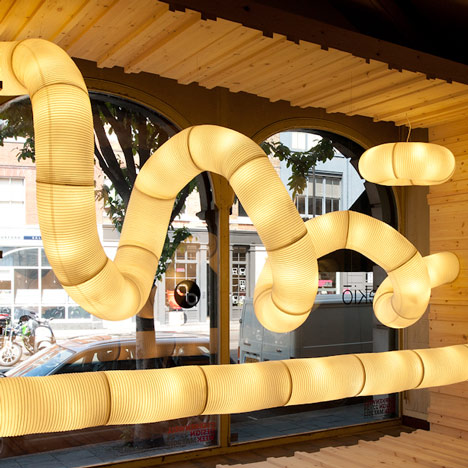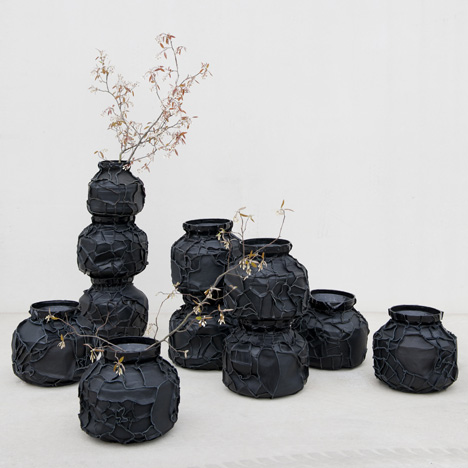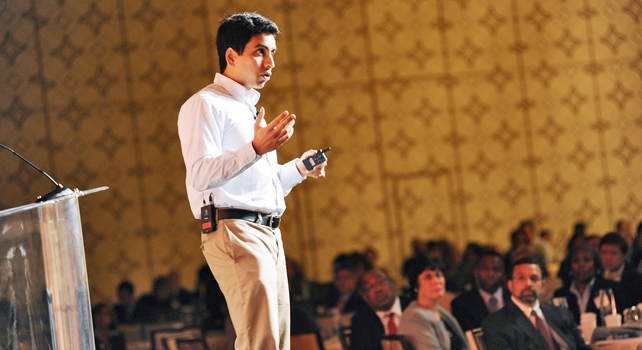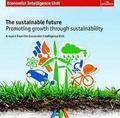Pollution Causing Bug-Eating Plants to Go Vegetarian
by: Eco Geek Latest, 2012-06-12 15:40:45 UTC

Every once in a while we hear of an unexpected consequence of pollution or climate change and this one is particularly interesting. Scientists at Loughborough University in England found that an increased level of nitrogen in rainfall over bogs in Northern Europe was causing carnivorous plant species to cut back or stop consuming insect prey because they were now getting more nitrogen through their roots.
Air pollution from the burning of fossil fuels at power plants and from transportation is causing the uptick in nitrogen in the rain. By taking samples of plants in different bogs and analyzing the nitrogen they contained, the scientists found that plants in areas where the pollution was light got 57 percent of their nitrogen from insects, but in areas with heavy pollution that number fell to 22 percent.
The plants are responding to the extra nitrogen by making their leaves less sticky and changing their color to more green instead of insect-attracting red, making bogs where nitrogen pollution is high easy to spot.
This change is actually to the plants' detriment. The plants originally evolved to be carnivorous in order to survive in the low-nitrogen environments of the bogs, but now that the plants are switching their diet they will find it harder to compete with non-carnivorous plants that are equipped better for a high-nitrogen environment.
"In the sites with more nitrogen deposition, these plants now get much more of their nitrogen from their roots, but they still have to bear the residual costs of being carnivorous, and other plants without these will be better able to survive,"said Dr. Jonathan Millett, the report's lead author. "So it's quite likely we'll see less abundance and perhaps local extinctions from carnivorous species. The individual plants get bigger and fitter, but the species as a whole is less well adapted to high-nitrogen environments and will lose out over time."
via Phys.org
Images via Wikimedia Commons
 1.5 Gigawatts from a Thermal Chimney Power Tower
1.5 Gigawatts from a Thermal Chimney Power Tower
by: Eco Geek Latest, 2012-06-12 18:30:56 UTC

Solar towers are again getting some notice. According to recent news, a company called Clean Wind Energy, Inc. is trying to build a 3,000 foot (914 meters) tall tower to produce electricity. When the tower is operational, the company expects to have, on an hourly basis, "1,100 to 1,500 megawatt hours available for sale to the power grid."
Solar power towers are one of the more unusual concepts we've come across at EcoGeek. More properly, we should be calling them something like 'thermal chimney towers' to differentiate them from the solar towers which are targets for fields of solar reflectors.
To further complicate the matter, there are two types of solar chimney towers: updraft and downdraft. Updraft towers require a large area covered with transparent material to heat the air at the base of the tower in order to make it rise through the chimney. Downdraft towers pump water to the top of the tower where it is sprayed as a fine mist to cool the air and induce it to fall. In both cases, wind turbines at the base of the tower are turned by the moving air to produce electricity.
The tower that Clean Wind Energy is proposing is of the downdraft type, which may be problematic in the American desert southwest, where water is already scarce. Treehugger's article on the project also notes one of the major drawbacks to this kind of power generator: "Of course, there's the problem of dedicating large amounts of water in a desert city to the tower, and the energy required to send it 3,000 feet up. One third of the energy produced by the tower goes to that pumping."
Several years ago, we first noted that Enviromission, an Australian company with an updraft tower design, was trying to get their first solar power tower built in Arizona. That company found Arizona more conducive to their business model than building a tower in the Australian desert, and their project also seems to be moving slowly forward. Whether either one of these towers (or both) gets built remains to be seen.
via: Treehugger
 Tekiō by Anthony Dickens
Tekiō by Anthony Dickens
by: Dezeen, 2012-06-17 17:00:20 UTC

London designer Anthony Dickens has created a snaking, modular lighting system made of bamboo and paper (+ movie). (more…)


 Matka Vases by Pepe Heykoop
Matka Vases by Pepe Heykoop
by: Dezeen, 2012-06-18 07:00:30 UTC

Dutch designer Pepe Heykoop has worked with people from one of Mumbai’s poorest areas to transform traditional water carriers into leathery vases. (more…)


 Wall of Planters Shades And Ventilates House; A New Kind of Living Wall
Wall of Planters Shades And Ventilates House; A New Kind of Living Wall
by: TreeHugger Design, 2012-06-15 14:10:57 UTC

Here is a great way to keep out the sun and plant a vertical garden
InaTrap insect killer takes insects out in designer style
by: Gizmag Emerging Technology Magazine, 2012-06-15 00:57:22 UTC

We know there’s an ongoing quest to build a better
mousetrap, but what about a better insect trap? That’s just what Acase, working with design house inadays, believes it has done with the creation of the InaTrap. With an appearance not dissimilar to a designer lamp, the InaTrap attracts, traps and kills insects so you can ditch the swatter and insect spray... Continue Reading
InaTrap insect killer takes insects out in designer styleSection: Around The HomeTags: Insect,
Light,
Mosquito,
Pests Related Articles: 




 How Khan Academy Is Going Global
How Khan Academy Is Going Global
by: fast company, 2012-06-14 16:04:57 UTC
Inside the online education juggernaut's mission to make their free lessons available in more than a dozen languages.

Khan Academy, one of the world's most popular educational sites, has a problem. People around the world want to learn online. However, the majority of world Internet users aren't fluent English speakers. For Khan Academy, the answer is obvious: Translate content, using the Internet as its translators. Quickly.
Many American high school and college student--as well as many adult, non-students--are already familiar with Khan Academy. The site, founded by former hedge fund analyst Salman Khan, hosts thousands of free, high-quality educational videos. Though most of the site's content focuses on mathematics, hard sciences, and computing, recent videos have begun covering the liberal arts as well.
The donation-funded non-profit has spent the past few years systematically porting their lectures and tests into over 16 foreign languages. Volunteer workers crowdsourced from the Internet work closely with Khan Academy supervisors to create subtitles for lectures, along with voiceovers for select videos. According to Khan Academy Dean of Translations Bilal Musharraf (Yes, that's his official title; Musharraf is the son of former Pakistani Prime Minister Pervez Musharraf), the organization crowdsources translators through Universal Subtitles' Amara platform, which recruits volunteers worldwide to write foreign language and closed-caption translations. Other Universal Subtitles clients include TED and PBS.
[youtube 4MAZwdEZIUs]
Translated content availability for Khan Academy varies wildly from language to language. Estonian is the most frequently subtitled language, with over 500 videos available, followed by Polish and Spanish. Dubbed content is available in 16 languages including Bangla, Hebrew, Malayalam, and Swahili. Musharraf tells Fast Company that each language has an official "Language Advocate" whose job is to review translations for accuracy and fluency. Language Advocates review both subtitles for Khan Academy videos and audio dubs.
Creating subtitled Khan Academy videos doesn't just boost the website's profile in non-Anglophone markets. Subtitles also help Khan Academy work SEO magic and lure in new viewers via Google and other search engines. The not-so-dirty secret is that video transcripts are fully searchable and can help make Khan Academy's content easier to discover.
While any Khan Academy user can subtitle videos, dubbing requires a stricter approval process. Potential voice-over volunteers undergo strict vetting by the non-profit; Khan places great importance on hand-holding voiceover artists and close supervision to guarantee accuracy and a consistent tone. In most cases, Khan Academy tries to use one voiceover person for each foreign language. Translators are expected to contribute a significant time investment; Khan Academy's Bangla project, for instance, requires at least 20 hours a week of volunteering.
Khan Academy's subtitle project began at the end of 2010 and is ongoing. Current language priorities, according to Musharraf, are Spanish, Portuguese, and Bengali. In the longer term, Khan Academy also plans to add original foreign language content--lectures and chats conducted from start to finish in non-English languages with no translation involved. Volunteers for translation are still being accepted.
For more stories like this, follow @fastcompany on Twitter. Email Neal Ungerleider, the author of this article, here or find him on Twitter and Google+.
[Image: Flickr user ACEducation]


 hironao tsuboi: omega for arflex japan
hironao tsuboi: omega for arflex japan
by: Designboom - Weblog, 2012-06-13 15:00:00 UTC

a hand crafted chair using traditional japanese techniques in an elegant manner.
read more
BMW i pedelec electric bike
by: Designboom - Weblog, 2012-06-15 10:50:00 UTC

the foldable electric bike concept is on exhibition in the world's first 'BMW i store', which just opened in london.
read more
TED: John Hockenberry: We are all designers - John Hockenberry (2012)
by: TEDTalks (video), 2012-06-11 15:24:20 UTC
Journalist John Hockenberry tells a personal story inspired by a pair of flashy wheels in a wheelchair-parts catalogue -- and how they showed him the value of designing a life of intent. (From The Design Studio session at TED2012, guest-curated by Chee Pearlman and David Rockwell.)









Comments by our Users
Be the first to write a comment for this item.